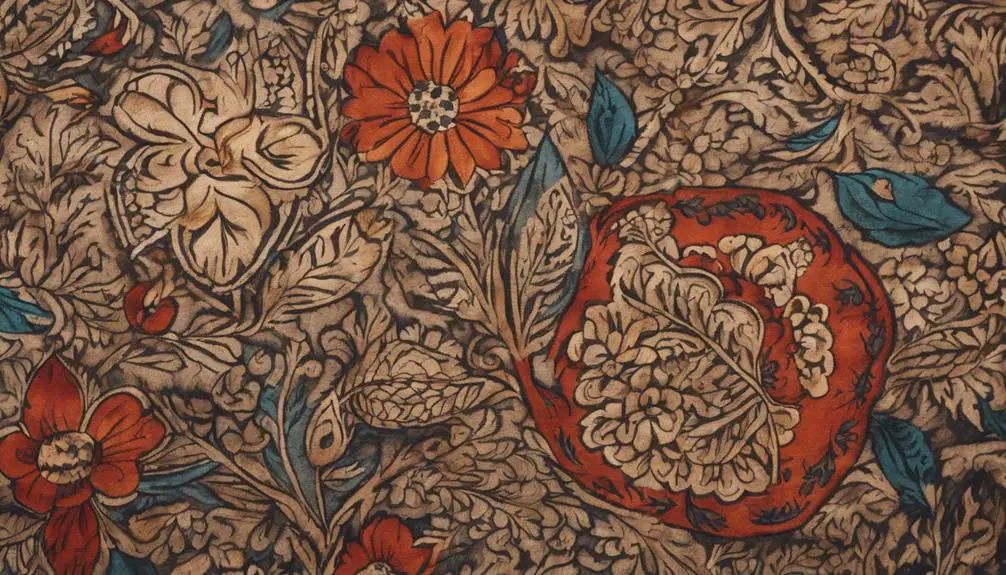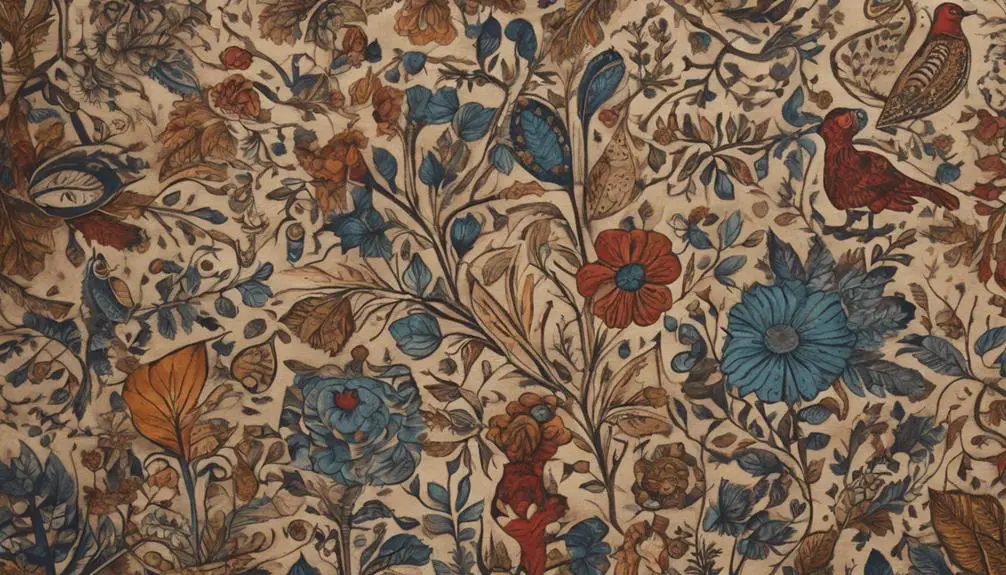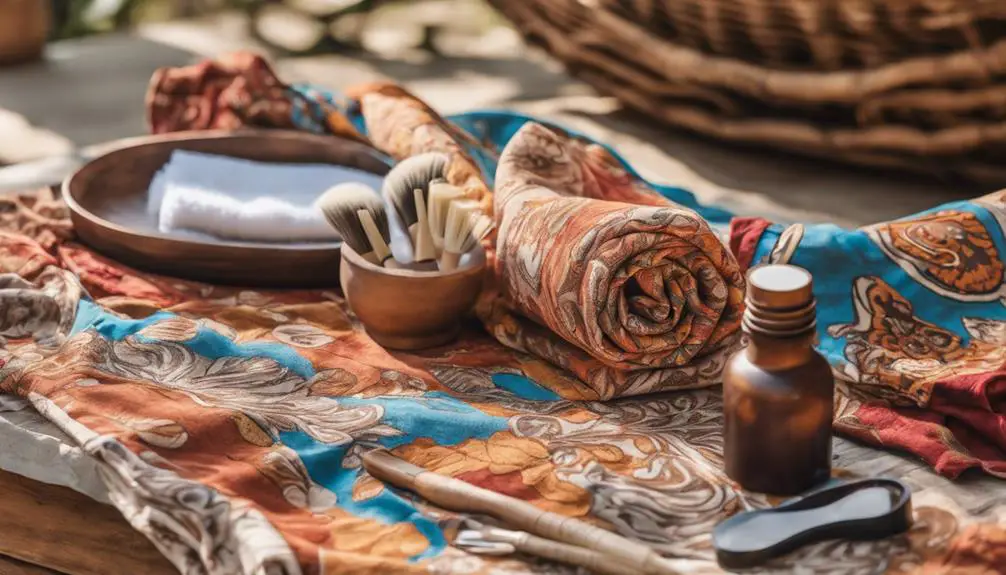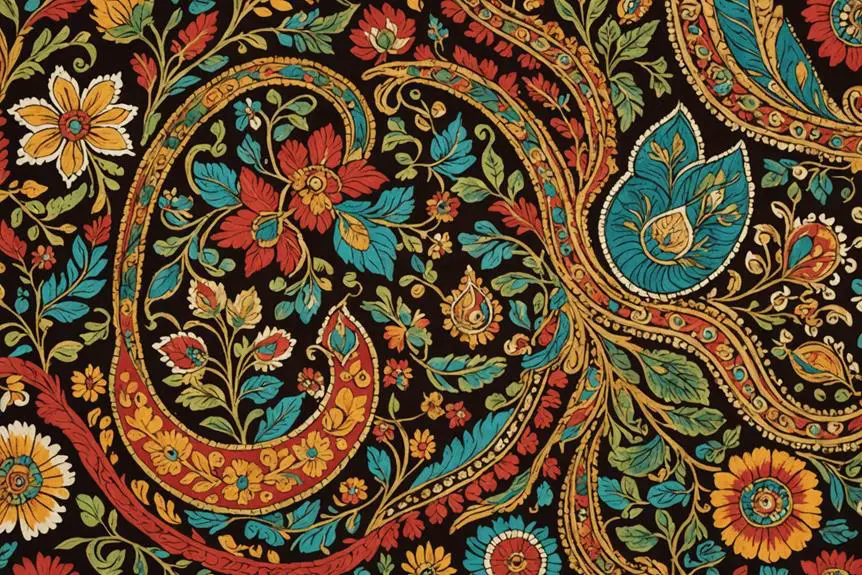When you want to identify authentic Kalamkari fabric, start by observing its earthy, muted colors and the subtle imperfections that reveal its handmade roots. You might notice a distinct milk scent that indicates traditional dyeing methods, along with a soft texture that sets it apart from synthetic options. Understanding the two primary styles—hand-painted and block-printed—can also guide your assessment. But these aren't the only factors to evaluate; there's more to uncover about the craftsmanship and care involved in Kalamkari that could deepen your appreciation for this art form.
Authenticity Indicators

Identifying authenticity indicators in Kalamkari fabric starts with observing its colors and textures. When you look at a genuine Kalamkari piece, you'll notice earthy, muted tones that come from natural dyes. If you see vibrant, bright colors, it's likely a sign of chemical dyes, which just don't belong in the world of authentic Kalamkari.
Next, check for charming imperfections. Authentic Kalamkari is hand-painted, so expect crooked lines and maybe even a smudge or two—these quirks enhance the fabric's beauty. Unlike machine-printed alternatives, these imperfections tell a story of craftsmanship.
You might also notice a distinctive milk smell. Yep, you read that right! This scent comes from the traditional dyeing process that uses buffalo milk, a true hallmark of authenticity. You'll want to get up close and personal to really catch that whiff!
Don't forget to feel the fabric. Authentic Kalamkari is made from organic fabrics like cotton or silk, which feel different from synthetic options. If it's too smooth or uniform, you might be looking at a fake.
And let's not ignore the block printing technique used in Srikalahasti Kalamkari. The irregularities and minor stains in the design further confirm its handmade nature. So, next time you're on the hunt for Kalamkari, keep these authenticity indicators in mind, and you'll find a treasure that's truly one-of-a-kind!
Visual and Sensory Characteristics
When you examine Kalamkari fabric closely, you'll notice a range of visual and sensory characteristics that set it apart from mass-produced alternatives. First off, the soft texture of authentic hand-painted Kalamkari feels so inviting against your skin. Unlike synthetic fabrics that can feel slick and cold, you'll appreciate the raw, cozy feel that comes from multiple washes during production.
Now, let's talk about the colors. Authentic Kalamkari boasts earthy tones that are produced using natural dyes. These muted colors might fade gracefully over time, giving them a unique charm. In contrast, fabrics with vibrant colors often rely on chemical dyes, which can be a giveaway that you're not dealing with the real deal.
When you hold a piece of Kalamkari, check for irregularities and minor imperfections in the design. These little quirks enhance its beauty and showcase the craftsmanship of individual artisans. You might notice slight inconsistencies in print sharpness and color variations, which are all part of the charm of quality fabrics.
Oh, and don't forget to take a whiff! The smell of milk is a telltale sign of genuine Kalamkari, stemming from traditional dyeing processes. If it smells like a chemistry lab, you might want to rethink your purchase. So, get ready to plunge into the world of Kalamkari and embrace its unique sensory experience!
Printing Techniques

Kalamkari fabric stands out largely due to its traditional printing techniques, which highlight the skill and artistry of the artisans. When you think of authentic Kalamkari fabric, you can't overlook the two main methods: hand-painted Kalamkari and block printing. Each one has its own charm!
In hand-painted Kalamkari, artisans use a cool pen-like tool, called a Pen Kalamkari, to create intricate designs. This method often shows delightful imperfections, like uneven lines and little smudges, which tell you that a real person made it—how neat is that? On the other hand, block printing involves carving designs into wooden blocks, which are then stamped onto the fabric. Both techniques really showcase the unique artistry of the craftsmen.
What's even more impressive is how they dye the fabric. Authentic Kalamkari uses natural colors made from vegetable dyes, giving the fabric those beautiful earthy tones. This multi-step process is what sets it apart from those machine-produced imitations that often look too perfect—flawless prints and synthetic dyes just can't compete!
Types of Kalamkari Fabric
The world of Kalamkari fabric is rich and diverse, primarily featuring two distinct types: Pen Kalamkari and Block Printed Kalamkari. If you're diving into the colorful domain of Kalamkari, it's crucial to know these differences!
First up, we have Pen Kalamkari. This style involves hand-painted intricate designs created using a pen-like tool. Imagine skilled artisans bringing folklore and mythology to life with their unique motifs! The craftsmanship is truly something special, as each piece showcases the artist's creativity. Plus, the color palette tends to be softer and more muted, thanks to the natural dyes used.
On the other hand, Block Printed Kalamkari has its own charm. This type uses carved wooden blocks to stamp patterns onto the fabric, resulting in repetitive designs that are usually more uniform. While it might lack the unique flair of Pen Kalamkari, it still brings a delightful vibe to printed fabrics.
Both styles rely on natural dyes, making them eco-friendly options for your wardrobe! But understanding the nuances helps you identify the authenticity and quality of Kalamkari fabric. So, next time you're shopping, keep an eye out for those intricate designs and the craftsmanship behind them.
Whether you're drawn to the detailed artistry of Pen Kalamkari or the uniform patterns of Block Printed Kalamkari, you're sure to find something that resonates with your style. Which one will you choose?
Care and Maintenance

Understanding the types of Kalamkari fabric is just the beginning; caring for these beautiful pieces is equally important. You want to make sure you preserve the vibrant natural dyes and maintain the fabric quality, right? Start with gentle washing. Use a mild detergent to keep those hand-painted designs looking fresh. Remember, harsh chemicals are a big no-no!
After washing, air out your saree in a cool room, maybe light some incense for that lovely aroma, but avoid direct sunlight. Sunlight can fade those gorgeous colors over time, and we definitely don't want that!
When it comes to storing your Kalamkari, keep it in a cool, dry place. Make sure it's completely cool before you fold and store it after ironing. A little tip? Avoid cramming it into a tight space. Give it room to breathe!
Regular maintenance is key to preserving the authenticity of your fabric. Gently handle your saree; think of it as a delicate treasure. You wouldn't want to ruin something so beautiful, would you?
Frequently Asked Questions
What Are the Characteristics of Kalamkari Fabric?
Kalamkari fabric's got some cool characteristics! You'll notice earthy colors, showcasing its rich kalamkari history. The traditional techniques used, like hand-painting and block printing, create unique designs and motifs that tell stories. Look for regional variations too; each piece reflects its artisan community. Plus, it's made from natural fibers, making it eco-friendly! With its cultural significance and contemporary uses, you can't help but appreciate the craftsmanship behind every piece. Isn't that awesome?
How Can You Tell the Difference Between Kalamkari and Pen Kalamkari?
You can spot the difference between Kalamkari and Pen Kalamkari by checking their techniques and designs. Pen Kalamkari's unique, freehand motifs show the artist's touch, while Kalamkari's block prints have repetitive patterns. Think of it like comparing a painting to a stamp! Plus, the textures vary: Pen feels softer due to washes, and it might even smell like milk! Isn't that fascinating? Each has its cultural symbolism, reflecting artisan communities and their history beautifully.
What Are the 2 Styles of Kalamkari?
You've got two main styles of Kalamkari: Kalahasti and Machilipatnam. Kalahasti features detailed hand-drawn designs, often telling stories from Hindu mythology. Isn't that cool? On the other hand, Machilipatnam uses block printing with vibrant patterns. Both styles showcase amazing craftsmanship skills and carry deep cultural symbolism. Plus, they're rooted in Kalamkari history and traditional techniques. So, whether you're into storytelling or bold designs, there's a Kalamkari style for you!
What Are the Colors Used in Kalamkari?
When you delve into Kalamkari, you'll notice it's all about those earthy, muted tones from traditional dyes. Think natural pigments like indigo and turmeric! These colors tell stories—each shade has its own color symbolism. Hand-painted pieces show unique dyeing techniques, reflecting regional variations and cultural motifs. If you see vibrant hues, it might be a red flag for chemical dyes. Embrace the eco-friendly practices and appreciate the historical significance behind this artistic expression!
Conclusion
So, there you have it! Identifying authentic Kalamkari fabric can be fun and rewarding. Just remember to look for those earthy tones, charming quirks, and that unique smell. Whether it's hand-painted or block-printed, each piece tells a story. So next time you're shopping, keep these tips in mind, and you'll impress everyone with your newfound knowledge. Isn't it cool to know what makes Kalamkari so special? Happy fabric hunting!




